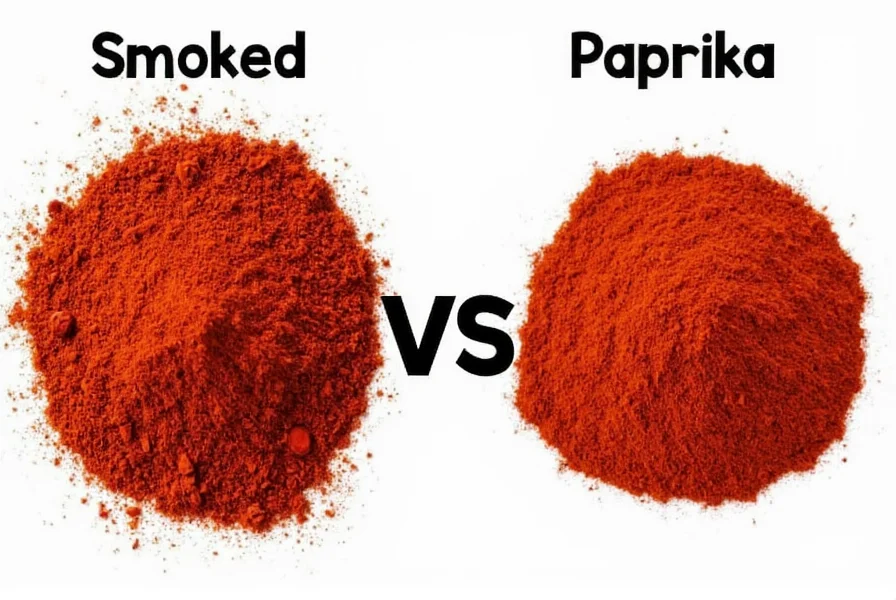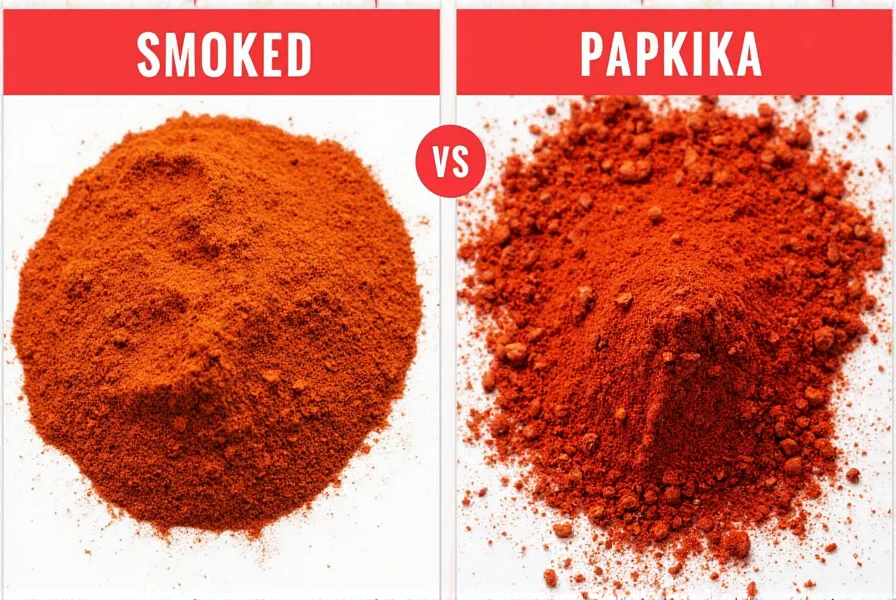Understanding the distinction between these two spice variants is essential for home cooks and professional chefs alike. Both originate from ground Capsicum annuum peppers, but their processing methods create dramatically different flavor experiences that can make or break your dishes.
What Exactly Is Paprika?
Regular paprika, sometimes called sweet paprika or Hungarian paprika, consists of ground dried peppers that have been air-dried in the sun or through mechanical means. Originating in Central Mexico but perfected in Hungary, this vibrant red spice ranges from mild and sweet to moderately hot depending on the pepper varieties used.
The traditional Hungarian method involves selecting specific pepper varieties, drying them carefully to preserve color and flavor, then grinding them into a fine powder. High-quality paprika maintains a brilliant red hue and delivers a clean, sweet pepper flavor with subtle fruit notes. It's a cornerstone of Hungarian cuisine, essential in dishes like goulash and chicken paprikash.
The Smoking Process: What Makes Smoked Paprika Unique
Smoked paprika, known as pimentón in Spain where it originated, undergoes an additional critical step: the peppers are smoked over oak or other hardwoods for several days before grinding. This traditional smoking process, often using specific regional woods, imparts that unmistakable smoky character.
The smoking duration and wood type significantly influence the final flavor profile. Spanish producers in regions like La Vera use traditional methods where peppers hang in smokehouses (secaderos) above oak fires for up to 15 days. This slow smoking not only flavors the peppers but also helps preserve them, historically important before modern refrigeration.
| Characteristic | Regular Paprika | Smoked Paprika |
|---|---|---|
| Production Method | Air-dried peppers ground into powder | Peppers smoked over hardwood before grinding |
| Flavor Profile | Sweet, bright pepper flavor with fruit notes | Distinct smoky, campfire-like flavor with pepper base |
| Heat Level | Mild to moderately hot (varies by type) | Mild to hot (varies by type) |
| Color | Bright red to deep orange-red | Rustic red to deep brick red |
| Primary Culinary Use | Traditional Hungarian dishes, color enhancement | Spanish cuisine, barbecue, smoky flavor applications |
Flavor Differences That Matter in Cooking
The flavor contrast between these spices goes beyond simple smokiness. Regular paprika offers a straightforward pepper flavor that can range from sweet to hot depending on the variety. High-quality Hungarian paprika provides a clean, vibrant pepper taste that enhances without overwhelming.
Smoked paprika, however, delivers a complex flavor experience. The smoking process creates compounds that add layers of flavor beyond just "smoke." Depending on the specific production method, you might detect notes of:
- Wood smoke (oak, hickory, or fruit woods)
- Subtle earthiness
- Leathery or tobacco-like undertones
- Occasional sweet or bitter notes based on smoking duration
These flavor differences aren't merely subtle variations—they represent entirely different culinary tools. Using the wrong type can dramatically alter your dish's intended flavor profile.
Culinary Applications: When to Use Each Type
Understanding when to use smoked paprika versus regular paprika separates novice cooks from knowledgeable ones. Each has specific applications where it shines:
Best Uses for Regular Paprika
- Traditional Hungarian goulash and paprikash
- Coloring rice dishes without adding smokiness
- Lighter sauces and cream-based dishes
- Marinades for delicate proteins like chicken or fish
- Adding subtle pepper flavor to soups and stews
Best Uses for Smoked Paprika
- Spanish dishes like patatas bravas and chorizo
- Barbecue rubs and smoked meat preparations
- Bean dishes (especially black beans and chili)
- Roasted vegetable seasonings
- Adding smoky depth to vegetarian "bacon" recipes

Substitution Guidance: Can You Swap Them?
Many home cooks wonder can I substitute smoked paprika for regular paprika and vice versa. The answer depends on your recipe and desired outcome.
Substituting smoked for regular paprika introduces a smoky element that may not belong in traditional Hungarian or Central European dishes. The reverse substitution (using regular paprika where smoked is called for) results in missing that essential smoky dimension, particularly noticeable in Spanish recipes.
If substitution is necessary:
- For regular paprika: Use 1 part smoked paprika + 2 parts sweet paprika to dilute smokiness
- For smoked paprika: Add a tiny pinch of liquid smoke to regular paprika (use sparingly)
However, for authentic results, using the specified type delivers the intended flavor experience. Understanding the difference between Hungarian paprika and smoked paprika helps maintain recipe integrity.
Storage Recommendations for Maximum Freshness
Both paprika varieties lose potency when exposed to light, heat, and air. To preserve their distinct flavors:
- Store in airtight containers away from light
- Keep in a cool, dark pantry (not above the stove)
- Use within 6-12 months for peak flavor
- Consider refrigerating in humid climates
Smoked paprika often maintains its flavor longer than regular paprika due to the preservative qualities of the smoking process, but both benefit from proper storage.
Common Misconceptions Clarified
Several myths persist about these spices. Let's address them:
- Misconception: Smoked paprika is always hotter than regular paprika.
Reality: Heat level depends on pepper variety, not smoking. Both come in sweet, bittersweet, and hot varieties. - Misconception: All paprika labeled "Spanish" is smoked.
Reality: Spain produces both smoked and non-smoked varieties. Check labels for "pimentón ahumado" (smoked) versus "dulce" (sweet). - Misconception: Hungarian paprika can't be smoked.
Reality: While traditional Hungarian paprika isn't smoked, some producers now offer smoked versions, though they differ from Spanish pimentón.

Choosing Quality Products
When selecting either spice, look for:
- Bright, vibrant color (dull color indicates age)
- Fragrant aroma when opened
- Clear labeling of origin and variety
- Opaque or dark glass containers to protect from light
High-quality paprika should smell fresh and distinctly of peppers, not musty or stale. The best products often specify the pepper varieties used and production methods, helping you understand what does smoked paprika taste like compared to regular before purchasing.
Can I use smoked paprika instead of regular paprika in Hungarian recipes?
While technically possible, substituting smoked paprika in traditional Hungarian recipes significantly alters the intended flavor profile. Authentic Hungarian dishes rely on the clean, sweet pepper flavor of regular paprika without smokiness. For authentic results, use regular Hungarian paprika as specified.
Does smoked paprika have more heat than regular paprika?
Heat level depends on the pepper variety used, not the smoking process. Both regular and smoked paprika come in sweet (mild), bittersweet, and hot varieties. Check product labels for heat indicators rather than assuming smoked means hotter.
How can I tell if my paprika has gone bad?
Stale paprika loses its vibrant color (becoming dull brownish-red) and develops a musty or cardboard-like smell instead of fresh pepper aroma. Properly stored, paprika maintains peak flavor for 6-12 months. If it lacks strong aroma when opened, it's time to replace it.
What's the difference between Spanish paprika and Hungarian paprika?
Hungarian paprika typically refers to non-smoked varieties with a sweet, clean pepper flavor central to Hungarian cuisine. Spanish paprika (pimentón) often refers to smoked varieties, though Spain produces both smoked and non-smoked types. The production methods, pepper varieties, and regional traditions create distinct flavor profiles between these national styles.
Can I make my own smoked paprika at home?
Creating authentic smoked paprika at home is challenging without proper smoking equipment. You can approximate it by smoking dried peppers in a smoker (8-12 hours at 150-180°F), then grinding them. However, commercial producers use specific pepper varieties and traditional smoking methods that are difficult to replicate precisely in home kitchens.










 浙公网安备
33010002000092号
浙公网安备
33010002000092号 浙B2-20120091-4
浙B2-20120091-4